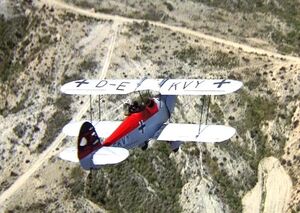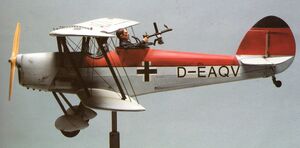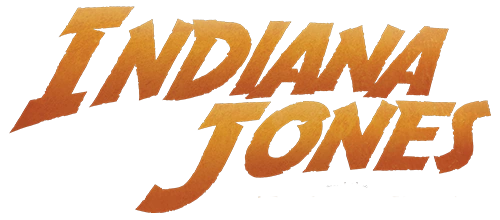
Escaping in D-EKVY in 1938.
- "Fly, yes! Land, no!"
- ―Indiana Jones[src]
The D-EKVY was a German military airplane designed for reconnaissance and defense. It had an open air cockpit, with two seats, one for the pilot, and one for a tail gunner. Attached to a zeppelin, it was meant to be launched from mid-air. While biplanes were frequently used in World War I, by the 1930s, they had started to become outclassed by newer and faster planes.
In 1938, Indiana Jones and his father, Henry Jones, Sr. used D-EKVY to escape from a zeppelin, and crash landed it after an air battle.
History[]
In 1938, Indiana Jones and his father, Henry Jones, Sr., were aboard D-138, a zeppelin bound from Berlin to Athens, when the airship began turning around after Jones had disabled its radio. Unwilling to return to Germany, the two searched the airship and discovered that it carried a biplane, and climbed aboard.[1]

Forced to land.
After they had detached from the zeppelin and began flying to freedom, the younger Jones realized that they were being pursued by two Nazi fighter planes. Giving his father a quick lesson in aerial combat lingo, Indiana concentrated on flying while his father began using the biplane's machine guns. As one of the faster fighters swung around the tail of the plane, Henry continued to track its motion and ended up shooting the tail fin of their plane.[1]
Unwilling to admit his mistake, he apologized to his son that they'd been shot by the enemy. With the rear stabilizer damaged, the plane could not stay aloft, and Indiana Jones looked for a place to ditch the plane. Nearing the ground, Jones managed to land on a hillside, crashing the plane into a farmhouse. The two escapees climbed out of the ruined plane and searched for a vehicle - eventually stealing a Citroën automobile.[1]
Behind the scenes[]
The actual plane used in the filming of Indiana Jones and the Last Crusade was a Belgian Stampe SV.4 biplane. Its actual registration is G-BHFG.[2] The presence of a tailwheel and the flush wing tank separates it from a British De Havilland DH 82 Tiger Moth. Indiana Jones: The Ultimate Guide refers to the plane as a modified Buecher biplane,[3] possibly meant to be a modified German Bücker Bü 131.
Originally, the film was going to include a second biplane, launched from the zeppelin, and flown by the World War One Ace and a Gestapo agent. These scenes were cut from the film but were left in the novelization and comic.[4][5] The film, however, clearly shows the zeppelin carrying only one biplane at takeoff.

German biplane model
From Star Wars To Indiana Jones - The Best of the Lucasfilm Archives identifies the model used by the ILM team as "German biplane". Note that the model uses a different set of call letters: D-EAQV, and has a model more similar to the Gestapo agent than to Henry Jones, indicating that this was the model for the second biplane.[6]
The German biplane was re-created as a collectible in the Titanium Series as the "Last Crusade Biplane". Facts about the plane on the Hasbro packaging include that the biplane was part of the Luftwaffe as a light fighter/bomber with a maximum altitude of 8,000 feet and was armed with 2 50mm machine guns, although its role with the zeppelin would be for defense and reconnaissance[7].
In Indiana Jones and the Last Crusade: The Graphic Adventure, there is a similar biplane parked at the Berlin airport. The player can choose to have Indy and his father board the biplane instead of the zeppelin, and has the opportunity to figure out how to start up the biplane before German agents reach it. To help the player start up the biplane, there is a manual for flying biplanes hidden in the library in Venice. If the player manages to take off in the biplane, the entire zeppelin level is bypassed, and the player must then try to evade Nazi fighter planes pursuing the biplane.[8]
After the tailfin is shot off, it can be seen whole again as the biplane flies down.
Appearances[]
- Indiana Jones and the Last Crusade
- Indiana Jones and the Last Crusade novel
- Indiana Jones and the Last Crusade comic
- Indiana Jones and the Last Crusade: The Graphic Adventure
- Indiana Jones and the Last Crusade: The Action Game
- Indiana Jones: The Search For Buried Treasure
Non-canonical appearances[]
Sources[]
- From Star Wars To Indiana Jones - The Best of the Lucasfilm Archives
The Last Crusade: Tiny stunt double on IndianaJones.com (backup link on Archive.org)
- Indiana Jones: The Ultimate Guide
- "The Thrill of the Chase!" - Indiana Jones: The Official Magazine 4
- Titanium Series (Pack: Last Crusade Biplane)
 8 New Discoveries in the Indiana Jones and the Great Circle Trailer on Lucasfilm.com (backup link on Archive.org)
8 New Discoveries in the Indiana Jones and the Great Circle Trailer on Lucasfilm.com (backup link on Archive.org)
Notes and references[]
- ↑ 1.0 1.1 1.2 Indiana Jones and the Last Crusade
- ↑ http://www.caa.co.uk/application.aspx?catid=60&pagetype=65&appid=1&mode=detailnosummary&fullregmark=BHFG
- ↑ Indiana Jones: The Ultimate Guide
- ↑ Indiana Jones and the Last Crusade novel
- ↑ Indiana Jones and the Last Crusade comic
- ↑ From Star Wars To Indiana Jones - The Best of the Lucasfilm Archives
- ↑ Last Crusade Biplane at ParryGamePreserve.com
- ↑ Indiana Jones and the Last Crusade: The Graphic Adventure
